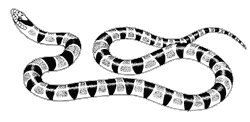Mohave Shovel-nosed Snake
(Chionactis occipitalis)
Order: Squamata
Family: Colubridae (colubrid snakes)
Spanish names: culebra, coralillo
Distinguishing Features
The western shovelnose snake is small, reaching 10 to 17 inches (25 to 43 cm). As the name implies, the snout is flattened and shovel-shaped. The lower jaw is deeply inset. The dark brown or black bands may be saddle-like or may encircle the body. The basic ground color is cream, whitish, or yellow. Red or orange saddles may or may not be present between the dark saddles. The scales are smooth.

Range
Strictly a desert dweller, this snake is restricted to southeastern California, southern Nevada, southwestern and central Arizona, northeastern Baja California, and northwestern Sonora, Mexico.
Habitat
This snake is found in loose sandy areas such as washes, dunes, sandy flats and rocky hillsides that have sandy areas between the rocks. Vegetation is usually sparse and may include creosote bushes, grasses, cacti, and mesquite.
Life History
The underset lower jaw, muscular body, smooth scales, and shovel-shaped nose make this snake very good at “swimming” in the sand. During the heat of the day it is usually submerged beneath the surface, emerging at night to hunt for food. It feeds on numerous kinds of insects (including their larval stages) as well as spiders, scorpions, centipedes, and moths. If disturbed, the western shovelnose snake may try to bury itself in the sand, climb into low-lying vegetation or form a ball with its coils, hiding its head deep in the coils. As many as 9 eggs are laid in the summer.










